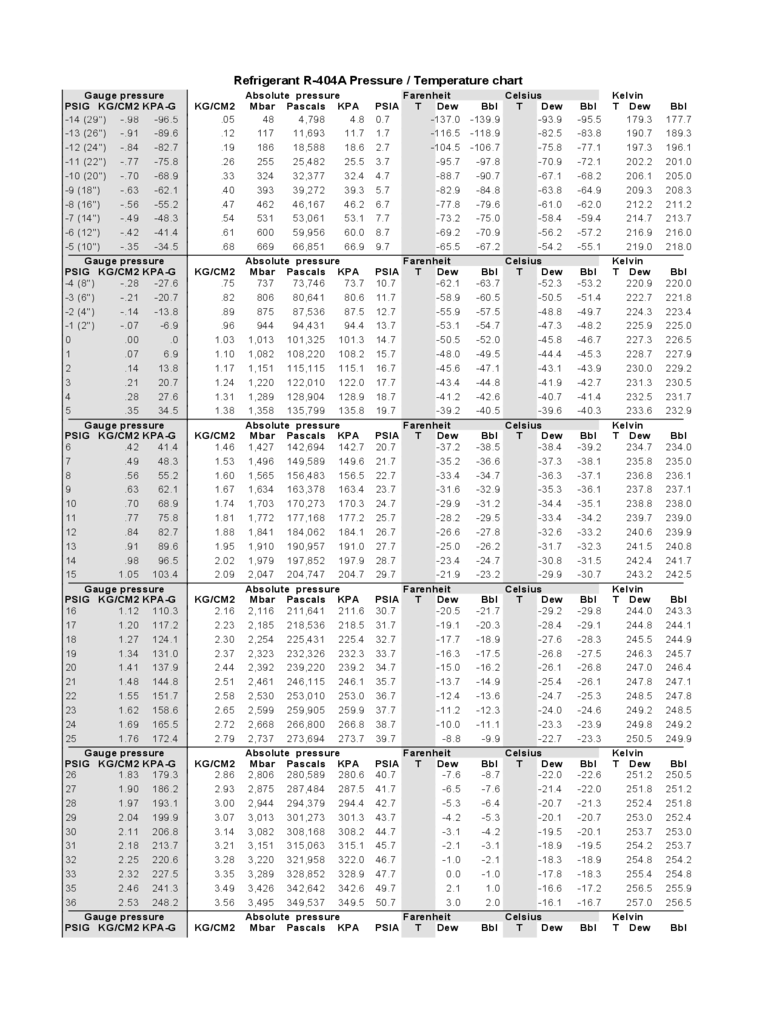With the advent of technology, air conditioning and refrigeration have become commonplace in our daily lives. As a professional in the industry, it is important to have a thorough understanding of refrigerants and their pressure-temperature relationships. In this post, we will explore various refrigerant pressure-temperature charts that are essential for any HVAC technician.
R134a Refrigerant Pressure-Temperature Chart
 One of the most commonly used refrigerants in air conditioning and refrigeration systems is R134a. The pressure-temperature chart for R134a provides essential data for determining the operating conditions of the refrigerant. The chart displays the relationship between the pressure and temperature of the refrigerant, allowing technicians to easily determine the refrigerant’s state and its capacity to perform effectively.
One of the most commonly used refrigerants in air conditioning and refrigeration systems is R134a. The pressure-temperature chart for R134a provides essential data for determining the operating conditions of the refrigerant. The chart displays the relationship between the pressure and temperature of the refrigerant, allowing technicians to easily determine the refrigerant’s state and its capacity to perform effectively.
R410a Refrigerant Pressure-Temperature Chart
 R410a is another widely used refrigerant in air conditioning and refrigeration systems. It operates at much higher pressures than R134a and therefore requires a different pressure-temperature chart. The R410a chart displays the relationship between the pressure and temperature of the refrigerant in a similar manner to the R134a chart.
R410a is another widely used refrigerant in air conditioning and refrigeration systems. It operates at much higher pressures than R134a and therefore requires a different pressure-temperature chart. The R410a chart displays the relationship between the pressure and temperature of the refrigerant in a similar manner to the R134a chart.
R404a Refrigerant Pressure-Temperature Chart
 The R404a refrigerant is commonly used in commercial refrigeration applications. The pressure-temperature chart provides useful information on the boiling and condensing points of the refrigerant, which is critical to understanding how the refrigeration system operates under various conditions.
The R404a refrigerant is commonly used in commercial refrigeration applications. The pressure-temperature chart provides useful information on the boiling and condensing points of the refrigerant, which is critical to understanding how the refrigeration system operates under various conditions.
404A Pressure-Temperature Chart Template
 While there are numerous refrigerant pressure-temperature charts available, it can be beneficial to create a chart specific to the refrigerants being used in your particular application. The 404A pressure-temperature chart template is one such resource that provides an easy-to-use format for creating a customized chart.
While there are numerous refrigerant pressure-temperature charts available, it can be beneficial to create a chart specific to the refrigerants being used in your particular application. The 404A pressure-temperature chart template is one such resource that provides an easy-to-use format for creating a customized chart.
PT Chart
 PT charts are commonly used in the HVAC industry to display the pressure-temperature relationships of refrigerants. They often include multiple refrigerants on a single chart and can provide valuable information for troubleshooting and system analysis. The PT chart can be customized to include specific refrigerants and operating conditions to suit the needs of the application.
PT charts are commonly used in the HVAC industry to display the pressure-temperature relationships of refrigerants. They often include multiple refrigerants on a single chart and can provide valuable information for troubleshooting and system analysis. The PT chart can be customized to include specific refrigerants and operating conditions to suit the needs of the application.
Refrigerant Pressure-Temperature Chart
 A refrigerant pressure-temperature chart is an essential tool for HVAC technicians. The chart provides an easy-to-use reference for determining the various operating conditions of a refrigerant, including boiling point, dew point, and critical point. A thorough understanding of the pressure-temperature relationship is critical to maintaining and repairing air conditioning and refrigeration systems.
A refrigerant pressure-temperature chart is an essential tool for HVAC technicians. The chart provides an easy-to-use reference for determining the various operating conditions of a refrigerant, including boiling point, dew point, and critical point. A thorough understanding of the pressure-temperature relationship is critical to maintaining and repairing air conditioning and refrigeration systems.
Refrigerants
 Refrigerants are chemicals that are used in air conditioning and refrigeration systems to transfer heat from one location to another. They are chosen based on their thermodynamic properties, including their boiling and condensing points, and their environmental impact. The refrigerants used in HVAC systems must comply with various regulations and guidelines to ensure their safety and effectiveness.
Refrigerants are chemicals that are used in air conditioning and refrigeration systems to transfer heat from one location to another. They are chosen based on their thermodynamic properties, including their boiling and condensing points, and their environmental impact. The refrigerants used in HVAC systems must comply with various regulations and guidelines to ensure their safety and effectiveness.
R134a Refrigerant Pressure-Temperature Sample Chart
 The R134a refrigerant pressure-temperature sample chart provides a quick reference for determining the operating conditions of the refrigerant. The chart displays the relationship between the pressure and temperature of the refrigerant, enabling technicians to troubleshoot and diagnose problems more easily.
The R134a refrigerant pressure-temperature sample chart provides a quick reference for determining the operating conditions of the refrigerant. The chart displays the relationship between the pressure and temperature of the refrigerant, enabling technicians to troubleshoot and diagnose problems more easily.
As an HVAC professional, a thorough understanding of refrigerant pressure-temperature charts is vital to your success. With these charts, technicians can troubleshoot and diagnose problems quickly and efficiently, ensuring that air conditioning and refrigeration systems operate effectively and efficiently.